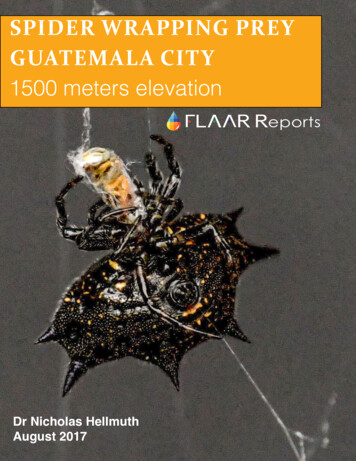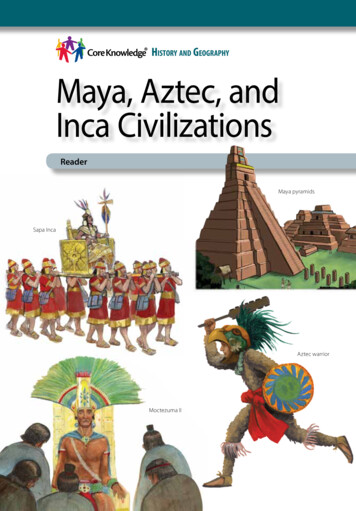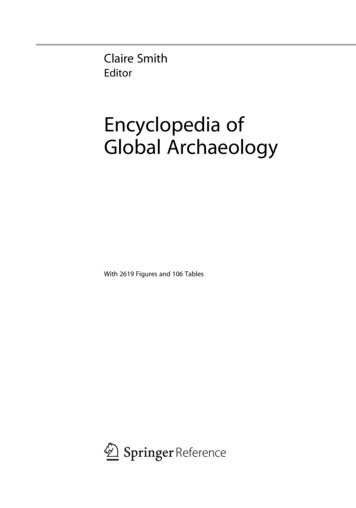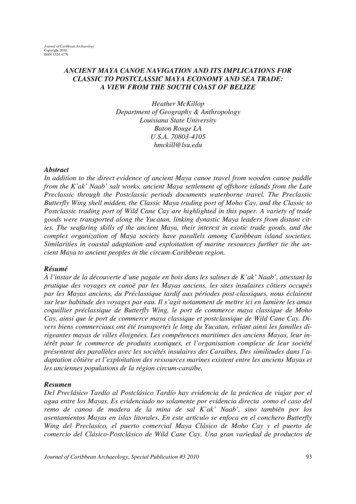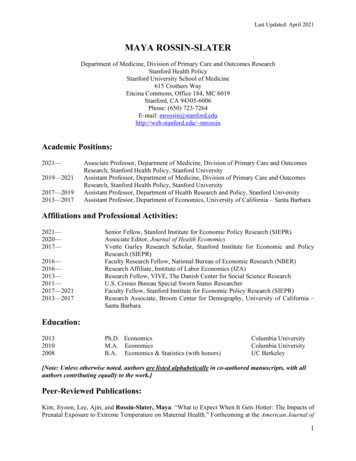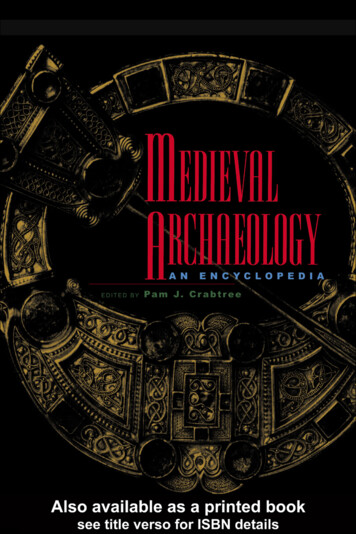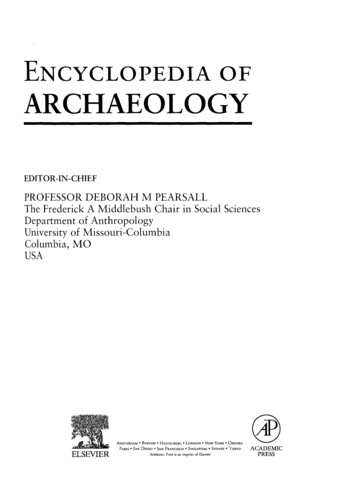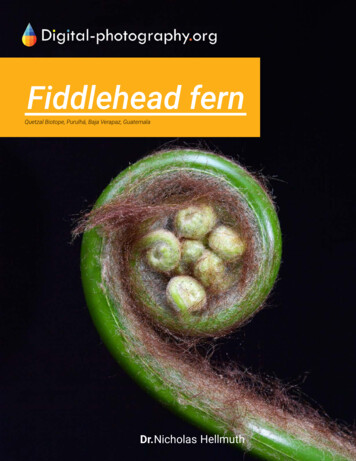
Transcription
Fiddlehead fernQuetzal Biotope, Purulhá, Baja Verapaz, GuatemalaDr.Nicholas Hellmuth
Nikon D810, AF-Micro Nikkor 105 mm, speed 1/1,125, f 10 - ISO 1,2501You can call these a frond or a leaf or a pinnae,I like the unfurling of the leaf because it’s the most photogenicpart of the tree ferns which can easily be photographed,an entire mature leaf is so large it is tough to photograph.
2Nikon D810, AF-S Micro Nikkor 105 mm, speed 1/1,125 ,f/10, ISO 1,250So often we have to photograph the fiddlehead portion from whatever position it is possibleto get the tripod into position. This is the same tree fern as the previous page, just that wechanged the angle. Since the quetzal reserve areas are on steep hills, we couldn’t get the tripod above the tree fern.
3This leaf structure still has the fiddlehead top but youcan see the sets of twin blobs which will unfurl to formhorizontal leaf structures on both sides.You can see moreof these blobs in the unfurled portion of the fiddlehead.Nikon D810, AF Micro Nikkor 200 mm, speed 1/250, f /10, ISO 1,250
4You can see one fiddlehead trying to riseabove the mature open leave structures.Nikon D810, AF Micro Nikkor 200 mm, speed 1/250, f/10,ISO 2,500
Nikon D810, AF Micro Nikkor 200 mm, speed 1/50, f/ 8, ISO 5005This is a close-up photograph of the fiddlehead portion of a young leaf which is not yetopened.
6Close-up photograph of the fiddlehead portion ofanother young leaf which is not yet opened. Theband of white marks almost looks like someonehas taken a needle-and-thread and stitched this.The right side is out of focus because the leftside and center are closer to the camera. Withthe wind you can’t always achieve stacked focus.Nikon D810, AF Micro Nikkor 200 mm, speed 1/80,f /7.1, ISO 3,200
7This fiddlestick istwisted (curved).Nikon COOLPIX B700, speed 1/50, f/ 8.0, ISO 400Photography: Senaida Ba
8Sometimes you see only onefiddlestick starting.Nikon 810 ,Nikkor lens 115mm, speed 1/10, frequency f/ 6.3, ISO 115But sometimes there are fourfrom the same trunk.Nikon COOLPIX B700, speed 1/25, f/6.3, ISO 400Photography: Senaida Ba
9After the fiddlestick opens up what will be thelateral parts of the leaf structure begin to unfurl.Nikon COOLPIX B700, speed 1/100, f /7.7, ISO 400Photography: Senaida Ba
10This is the stipe, the top of the “trunk” from which the “leaves”end up as fiddlehead shape after growing a bit. On this treefern the new leaf structure has not yet sprung out of the stipe.Nikon D810, AF Micro Nikkor 200 mm, speed 1/125, f /10, ISO 1,250
11Here is another view of the top of the trunk wherethe leaves start. You can see that one fiddlehead portion has already started (in the middle).Nikon D810, AF Micro Nikkor 200 mm, speed 1/250, f /10, ISO 2,500
12This is a separate photograph than the previous one, but acloser view. You can see the curl of the top of the fiddlehead.Nikon D810 , AF Micro Nikkor, lens 200 mm, speed 1/160, f /10,ISO 1,250
13Stacked focus of several trunks.Nikon D810, AF Micro Nikkor 200 mm, speed 1/80, f /7.1, ISO 3,200
14Leaves format a geometric shape, captured with a200mm tele-macro lens (the macro aspect was notused for something this far away).Nikon D810, AF Micro Nikkor 200 mm, speed 1/250, f /8.0, ISO 3,200
Introductory Bibliography onTree Ferns15(used by the Maya)BREWER, Steven W.2013 Plant Diversity & Vegetation. Belize. 42 0FinalPUBLIC v2013.12.09.pdfLEMA Costas, Cesarn.d. Plantas y frutos silvestres comestibles. A.N.D.R.E.A (Asociación Nacional para la Defensa, Recuperación y Estudioterapéutico de la raza Asnal). Spain.Available as a free r-lema-costas.pdfLOPEZ Lopez, Jessica Esmeralda, ENRIQUEZ, Eunice and Mario Esteban VELIZ2006 Riqueza y usos de helechos arborescentes en diferents regions biogeograficas de Guatemala. USAC. 24 pages.Available on-line // no cost:h t t p : // s i t i o s . u s a c . e d u . g t / w p e d c / w p - c o n t e n t / u p .pdfMAUDSLAY, Anne Cary and Alfred PercivalMAUDSLAY1899 A Glimpse at Guatemala, and Some Notes on the AncientMonuments of Central America. John Murray, London(Taylor and Francis). 289 pages.Available as free download, but was useless (and they don’tbother to correct scanning , Mario and Jorge VARGAS2006 Helechos arborescentes de Guatemala distribucion, diversidad, usos y manejo. FONACON. 94 pages.The best opus on tree ferns of Guatemala.WILSON, Michael “Mike”1972 A Highland Maya People and their Habitat: The NaturalHistory, Demography and Economy of the K’ekchi’. PhDdissertation, University of Oregon. 475 pages.Available on-line at no cost.An outstanding dissertation on plants of the Q’eachi’, however hisstudy area, San Pedro Carcha, is very different eco-system thanother Q’eqchi’ areas of Guatemala (and Belize). Unfortunatelyhe seems to be deceased which is unfortunate since his lists ofplants (and animals) is quite good.Web sites that mention the useof tree ferns of Guatemala inconstructing Mayan houseswww.chelemha.org/bevoelkerung.htmRiqueza y usos de helechos arborescentes en diferents regions biogeograficas de Guatemala. USAC. 24pages.
Appendix A16What Photographic Equipment is GoodThe Nikon D810 is great if you want to havelarge file size. The Nikon D5 is significantlybetter if you need a high ISO without fuzz. TheNikon D5 is also good for burst shooting. Butto do fast shooting the file size has to be a bitless.An advantage of the Canon EOS series is thatyou can use their 5x macro lens (MP-E, 65mm).There is no Nikon equivalent or even close.Canon also offers a ring flash: there is no Nikonmade ring flash. We use a cheap Chinese ringflash when we are in a hurry or a Metz if wedon’t mind spending a bit more time.All professional quality Gitzo tripods made 15to 30 years ago are long-lasting and well designed. I use only Gitzo tripods. I used a tripodon all photographs in this report which weretaken with the Nikon D5 or Nikon D810. Anyphotos taken with the Nikon B700 (point-andshoot) did not use a tripod, though if you intendto use it’s awesome telephoto ability, most photos do not focus well or get you get an unfuzzyshot unless you would use a tripod.The Wimberley WH-200 Gimbal Head VersionII is great for when we use a 400mm lens.We also sometimes use it for a 200mm. Onlyquirk is that sometimes the sliding part (upand down) can’t be locked (causing it to fall offwhen you carry it off the tripod).We bought two of these gimbals in past years(one for the Canon EOS 1DX Mark II (with its300mm lens) and one for the Nikon D810 (withits 400mm lens) and just bought a third one(for the Nikon 600mm lens we need, which wehave a Nikon D5 camera body).Gitzo tripod,WimberleyWH-200 GimbalHead II, NikonD5.So when we have a full team we have twoNikons and one Canon camera at work. We alsohave a Nikon CoolPix B700 for the assistantsto take snapshots with. It is great for telephotobut without a tripod is barel usable at telephotorange. And it does not focus close-up whatsoever (so is awful for macro photography).For telephoto lenses we use only Nikkor orCanon, and only prime lenses (not zoom). Wehave Nikkor and Canon zoom lenses which arehelpful for other kinds of photography, but toget a photograph of a quetzal, or the fiddleheadof a tree fern, I do not want to use a zoom lensand definitely not a Tamron or Tokina or even aSigma lens. But we do have a solid 50mmSigma lens and we do also have a 100mmZeiss lens (which has the world’s worst lenscap attachment component).
17Appendix BWhat Photographic Equipment isNOT GoodMany of the Arca-Swiss tripod heads (after thefirst large model which is the best made in theworld) are unusable; they have unrepairable defects (they were too complicated and it took Arca-Swiss too many years to admit that perhapsthere really was either an engineering designdefect or an inappropriate component; normally they blame it on the end-user’s inability (tofigure out how to use such bewildering dial andpressure points). Ironic that Arca Swiss madethe world’s best tripod head circa 1960’s or1970’s and then the next (smaller) generationwas the world’s worst.But at least the original Arca Swiss plate (forputting on the bottom of your camera) was agood idea. However avoid any Arca Swiss styleplate that don’t use a normal screw; when offon a field trip you need to be able to use a cointo tighten it. If it requires a special tool (like anAllen wrench) to tighten the screw, then YOUhave been screwed (since you can’t screw itwith any normal screwdriver).I have what appears to be a B1 Arca Swiss(they carefully don’t put the model designationon it). Whatever model it has been repaired atleast twice and then locks within a few days ofuse. None of the features work (they jam).We use Wimberley plant clamps. The firstmodels were awful; we stated so clearly on ourwww.digital-photography.org that Wimberleyappears to have listened, and came out withnew design. It is better than the old ones butdefinitely not as good as “Made in Germany(1960’s through 1980’s).”Going to Harvard and having had threepost-graduate fellowships at Yale does notnecessarily mean you can figure out how tomake an Arca Swiss early model B1 tripodhead work. The fact that they came out withsubsequent models is all the more suggestionthat perhaps the early model really was potentially badly thought out).This is what happens when you are too convinced that your engineering capability is superior: sorry, it’s the worst engineering (or theworst components) of any tripod I have usedin the 40 years I have been a photographer).To survive better with any Arca Swiss ball head,read the helpful info from www.precisioncameraworks.com/Pages/monoball core.htmlThe ACRATECH ball head is okay perhaps fora lightweight point-and-shoot camera, but aprofessional camera like the Nikon D5 simplyleans over (the ACRATECH simply can’t holdthe weight). But the release trigger concepttakes less time than attaching and unscrewingany and all Arca Swiss systems from the plateon the bottom of your camera.
hotography.org
Available as free download, but was useless (and they don’t bother to correct scanning errors). VELIZ, Mario and Jorge VARGAS 2006 Helechos arborescentes de Guatemala distribucion, diver-sidad, usos y manejo. FONACON. 94 pages. Available on-line at no cost. WILSON, Michael “Mike” 1972A Highland
